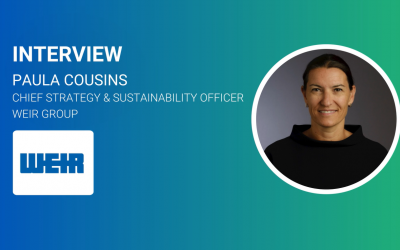Gareth Thomas on Enabling Nature-Positive Asset Allocation
Nature Finance Forum Europe: Your Questions Answered
.png)
Climate Action caught up with Gareth Thomas, Head of Research Innovation at the Natural History Museum, to answer some of the questions asked by the audience during his session: Managing what we measure. The session focused on understanding best practices for nature-related metrics and reporting, with some lively discussion surrounding detail vs comparability. Read below to see why Gareth believes this is a false binary.
Without embedding into regulations, how can nature assessments/disclosures be effective in enabling nature-positive asset allocation?
Regulatory mandates would certainly accelerate adoption, but nature assessments and disclosures can still be highly effective in shaping asset allocation; if they’re credible, consistent, and commercially meaningful. The reality is that most investors don't wait for regulation to manage risk. They act when there’s clear materiality, decision-useful data, and competitive advantage. That’s where tools like the Biodiversity Intactness Index (BII), developed by the NHM's Biodiversity Future's Lab, come in.
BII provides a scientifically grounded, location-specific, and policy-aligned view of ecosystem condition; without relying on company-reported data. This means asset managers can assess ecosystem health at scale, screen exposure to degraded areas, and build nature-positive strategies rooted in science. It gives a stable, trusted foundation for decision-making that doesn’t depend on voluntary disclosures.
To be effective in the absence of regulation, disclosures must move from tick-box to transformative. That means focusing less on frameworks and more on outcomes. Nature metrics need to show meaningful differences between assets, portfolios, or geographies, not just compliance with emerging norms. They must also be linked to real-world ecological outcomes. If a “nature-positive” label isn’t backed by empirical change, e.g., increasing BII values over time, then it’s just noise.
The answer therefore is twofold. First, equip investors with science-led, decision-ready, and scalable data that lets them act with or without regulation. Second, build a market culture where nature-positive positioning has reputational, strategic, and capital benefits. We're already seeing leading investors differentiate based on biodiversity alignment; the key is ensuring the tools they use actually reflect ecological reality, not just disclosure completeness.
How do you balance the need for location-specific data vs the need for global standardised nature metrics and standards for comparison?
This is one of the most critical tensions in nature assessment; and it’s a false binary. We don’t have to choose between local detail and global comparability. What we need are metrics that do both: grounded in ecological reality but structured in a way that supports system-wide assessment and decision-making.
That’s why the Biodiversity Intactness Index (BII) is so valuable. It’s built from empirical data; real-world biodiversity responses from over 60,000 species across 50,000 sites, yet it’s standardised through a globally consistent modelling framework. That means you can compare a sugar plantation in Southeast Asia with a forestry concession in South America using the same underlying metric but still understand how each site’s local land use and pressures shape biodiversity outcomes.
Location matters, because biodiversity is inherently spatial. But without standardisation, decision-makers are left with patchy, incomparable datasets that can’t be aggregated or benchmarked. A good metric should retain spatial granularity while enabling consistency. BII does that by using local land use, human population density, and infrastructure data to produce 1 km resolution outputs that are still globally coherent.
Of course, there’s also a role for hyperlocal data; rare species, endemic populations, cultural or Indigenous values. But these should complement, not replace, standardised metrics. In practice, the best assessments layer these approaches. You use BII for consistent baseline screening, then overlay site-specific data where it exists and is relevant to the decision. Moreover, the gold-standard would include on-the-ground assessments which feed into the standardised and layered data.
Ultimately, balancing local and global means recognising they serve different but complementary purposes. The key is interoperability, ensuring that local insights can plug into global systems, and vice versa. We should build frameworks that respect local nuance without sacrificing strategic alignment.
3. Is the data actually out there to assess “nature positive” across entire operations? Should organisations actually be using this term?
This term “nature positive” has become aspirational shorthand, but it risks becoming vacuous if we don’t anchor it in measurable outcomes. Right now, most organisations don’t have the data to assess nature-positive performance across their entire operations. And many of the tools being used don’t measure ecological reality; they measure disclosures, risk proxies, or intentions.
That’s why we need to be precise about what “nature positive” means. For it to have scientific credibility, it must reflect actual ecological improvement. That means measuring baseline condition, tracking change over time, and assessing whether ecosystems are recovering. State of nature metrics like the Biodiversity Intactness Index (BII) can help here. These metrics quantify the percentage of original biodiversity remaining in an area; albeit with varying methodologies. If that number is rising because of restoration, reduced pressure, or changed land use, we can credibly say that nature is recovering.
But most “nature positive” claims don’t use state of nature metrics. They rely on site-based certifications, species lists, or pressure proxies. Those have value, but they’re not the same as ecological condition. Without an outcome-focused metric, we risk seeing nature-positive claims with no empirical basis; just as we saw “net zero” claims that weren’t backed by real emissions reductions.
Should organisations use the term? Yes, but with caution. Use it only if it's grounded in measurable improvement, spatial attribution, and ecological plausibility. Don’t make it a branding tool, make it a performance threshold.
And be honest: for many organisations, the first step is becoming nature neutral; understanding where harm is occurring and stopping it. Only then can we talk about positive impact. The data is emerging, but it’s not universally adopted yet. Until it is, “nature positive” should be a goal, not a claim.
Watch the Nature Finance Forum Europe on-demand here
Register interest for 2026 here






